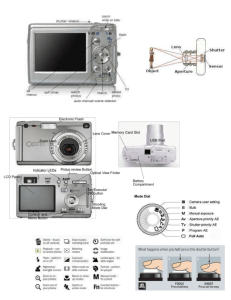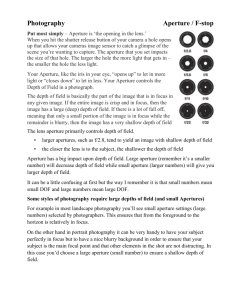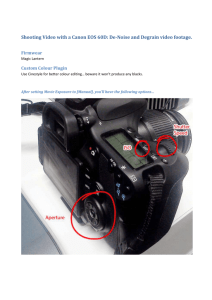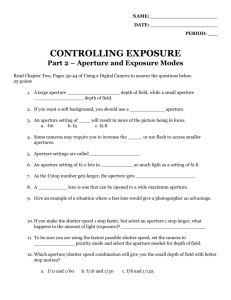Aperture Worksheet
advertisement
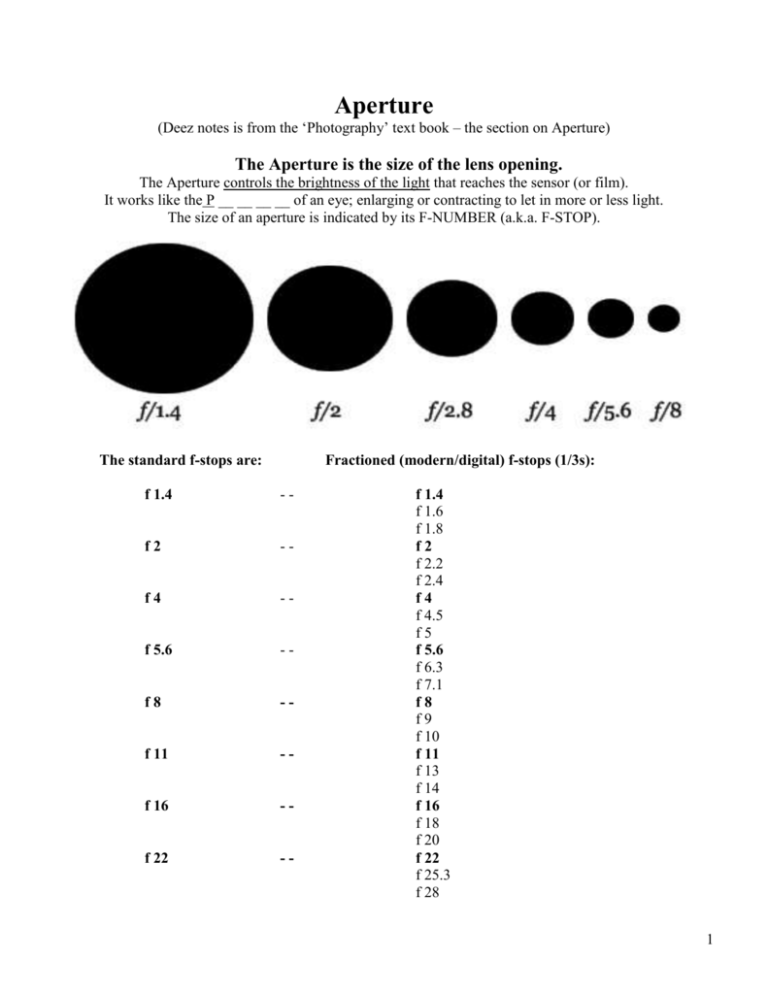
Aperture (Deez notes is from the ‘Photography’ text book – the section on Aperture) The Aperture is the size of the lens opening. The Aperture controls the brightness of the light that reaches the sensor (or film). It works like the P __ __ __ __ of an eye; enlarging or contracting to let in more or less light. The size of an aperture is indicated by its F-NUMBER (a.k.a. F-STOP). The standard f-stops are: Fractioned (modern/digital) f-stops (1/3s): f 1.4 -- f2 -- f4 -- f 5.6 -- f8 -- f 11 -- f 16 -- f 22 -- f 1.4 f 1.6 f 1.8 f2 f 2.2 f 2.4 f4 f 4.5 f5 f 5.6 f 6.3 f 7.1 f8 f9 f 10 f 11 f 13 f 14 f 16 f 18 f 20 f 22 f 25.3 f 28 1 Aperture (continued…) **Note: some camera lenses go as low as f1 and others as high as f64 The smaller the number (the lower the number) the more light the aperture lets in. In fact, each full f-stop smaller lets in twice as much light! For example: f 4 lets in twice as much light as f 5.6. Therefore, one f-stop higher (higher number) lets in ______________ as much light as the f-stop below it. For example: f 16 would let in _____________ as much light as f 11 On the left, in the top image (#1) you can see that the the aperture opening (the diaphram), is much more open than the aperture opening in image #2. The aperture setting in image #1 is letting more light in. The aperture setting of the top lens (#1) might be: f 2 The aperture setting of the bottom lens (#2) might be: f 22 SPEED! Lenses are often described as ‘fast’ or ‘slow’ lenses. This term refers to the maximum aperture (the smallest f-stop) for the lens. A lens that opens to f 1.4 is said to be faster than a lens with a maximum aperture of f 2. Faster lenses… a) Allow you to shoot more easily in low light (or at higher shutter speeds) b) allow for a more shallow depth of field c) are way more expensive! 2 For example: Canon, EF 300mm f4.0 L IS USM $1400 Canon, EF 300mm f2.8 L IS USM $4600 The main difference between these lenses (besides the price) is that the one on the right has an aperture of f2.8 and the one on the left has an aperture of f4.0. Therefore, the one on the right can let in twice as much light (one f-stop difference) for an extra $3200 dollars! DEPTH OF FIELD Depth of field is… ‘the area of acceptable sharpness (focus) in a picture’ The smaller the aperture (ie. larger aperture number) the GREATER THE DEPTH OF FIELD The larger the aperture (ie. smaller aperture number) the LESS DEPTH OF FIELD! For example: an image taken with f 22 will have more things in focus than an image taken at f 2 (which will have a very limited focal range) Note: you can not see the change in depth of field through the viewfinder in most DSLR cameras. Some do have a depth of field viewer or function. 3


